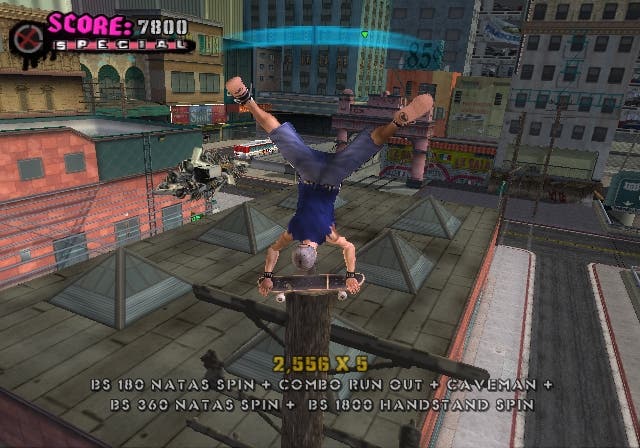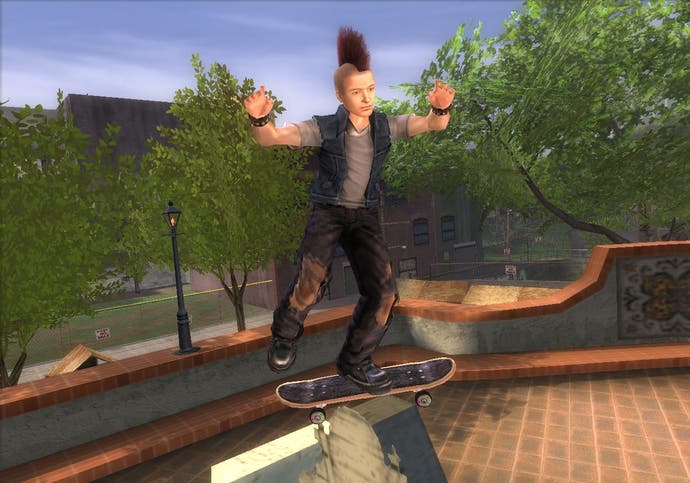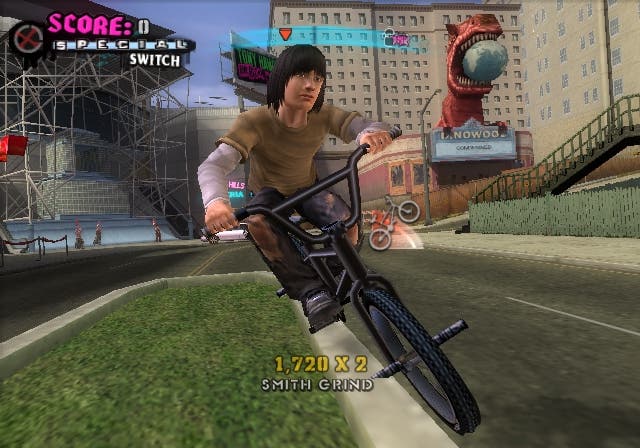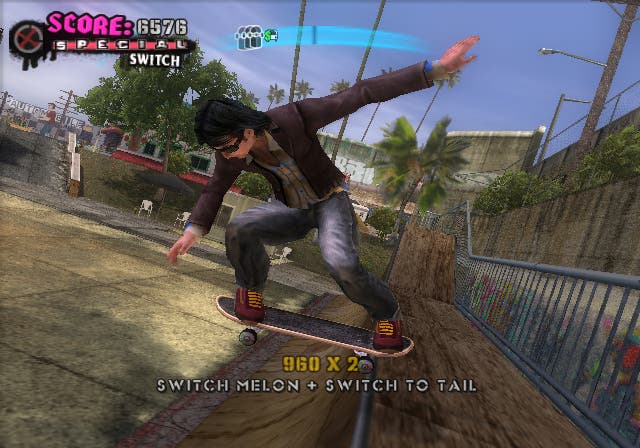Tony Hawk's American Wasteland
New tricks, same old dog.
To give a little credit where it's due, you have to hand it to Neversoft for managing to keep the Tony Hawk franchise alive as long as it has, in spite of losing the Pro Skater tag and dragging the series away from its board-based roots into the more surreal, motorised contraptions found in the two Underground titles.
That said, you also have to wonder if there's anything left to throw into the mix without completely destroying what has traditionally made the games so damn playable - especially after the reprehensible attempt at cashing in on the popularity of MTV's Jackass in last year's offering, THUG 2.
Certainly, the appearance of Classic mode in the last game provided Neversoft with a little respite from the angry masses, who found the free-roaming zero-to-hero story mode a little hard to swallow. But it seemed to be more of a confused attempt at pleasing all of the people all of the time than a worthy addition that would prevent the series from becoming tired and stale. The very fact that the classic style of gameplay has been reintroduced should give some indication that the series has perhaps taken things too far in the wrong direction, creating too radical a diversion to keep even the most ardent fans happy. Presumably, this is the reason for American Wasteland trying to take things back to basics in many ways. And while the classic mode is back in play to satisfy the desires of the clock-watching adrenaline junkies, the single-player story places a much heavier focus on traditional skating than we've seen since the original Pro Skater titles.
Hollywood or bust

Stepping into the shoes of one of five generic skater types, you're transported from the dull country life, to the centre of LA in an effort to bust out some tricks in the equivalent of a skating Mecca, where it all began all those years ago. Naturally, your redneck sensibilities don't go down to well in the big city, and you're promptly mugged after stepping off the bus. Thankfully, a young lady by the name of Mindy takes you by the hand (a trend that plagues the entire story mode - but more of that later) and invites you to restyle your hair and clothing to blend in better with the locals. Mindy then becomes your guide to the area, introducing you to the availability of shops and skate sponsors to change your look, upgrade your equipment and, more importantly, increase your stats through daily score/trick/combo-style sponsor challenges.
The main thrust of the story mode is an attempt to create the greatest skate park imaginable - dubbed American Wasteland - by gathering various items from each of the game's areas and having them shipped off to the initially barren waste ground, hidden away in a quiet corner of Beverly Hills. Unfortunately, before you can even discover the existence of the skate park, you'll be forced to re-learn everything the previous games have taught you. Aside from the odd new trick like the surfing-inspired Bert-slide and some on-foot stuff thrown in for good measure, the game insists that you must cover old ground by proving your skills (again) to a bunch of local miscreants who, unlike Mindy, don't take kindly to strangers muscling in on their turf. This, sadly, is just the beginning of a series of underwhelming 'skate-by-numbers' tasks as you 'learn' how to ollie, grind, manual, revert, flip, kick, grab and so on. It may well have served as a nice tutorial, were it not for the fact that this is the seventh game in the series and the basic controls haven't altered from what's gone before. It makes the whole thing a chore that, from the outset, feels unnecessary and more than a little lazy on Neversoft's part in terms of their failure to create an imaginative new set of challenges.
Fetch me this...

As the story progresses, so do the tricks available to you, with various challenges opening up new areas of LA to skate in. If you believed, as I did, the promise of a seamless universe akin to San Andreas, allowing you to skate freely throughout LA with no loading screens to break up the action, you may well be disappointed. In what has turned out to be a rather canny bit of PR spin, the truth of the matter is that there are still distinctly separate areas, which are linked by a small tunnel. It's true that there are no loading screens as such once you enter the game, but it's nowhere close to the smooth, free-roaming world we were led to believe in.
Once a new area has been unlocked, you can perform a running combo that transports you from one side of the tunnel to the other, but the transition is uninspired, consisting of little more than a series of basic grinds and pipes. Because the game is loading up the new area as soon as you enter the tunnel, there's often some lag and stuttering frame rates as you pass from one end to the other. You can also ride a bus or drive a car between areas, and, aside from removing the pleasure of skating around the area and discovering new trick lines, these journeys definitely feel like thinly veiled, animated loading screens, brief though they may be.
As you weave your way from Hollywood, through Beverly Hills, into Downtown past East LA and out to the sea front at Santa Monica, you'll encounter a range of objects, landmarks and scenery structures that would make for an outstanding skate park. Getting hold of these objects is all too often a painfully simple task of grinding support wires, wall-planting to shake things loose or landing in the right spot from a great height. It might not have been as basic was it not for the fact that you're always placed in the exact position you need to be in order to launch off the right ramp, hit the specific rails and so on. What's more, the hand-holding technique stretches further by giving you more than enough time to complete the challenge and filling the screen with step-by-step instructions such as "jump here" "grind here" "press R2 here" combined with the icon for the button-press required. The babysitting is prevalent on all difficulty settings and turns the story mode into what feels like one big tutorial. It gently pushes the story forward and just when you've convinced yourself it's about to get challenging, it's all over.
...buy me that
Throughout the game you can take a detour from the story challenges to pick up some cash, which can be used to kit yourself out with new gear or change your appearance to temporarily stave off the boredom. A bit of the green stuff is also needed for a few of the story challenges, and if you're a little short, you need to entertain the locals to top up the funds. Maybe it's just me, but I always thought offering to perform tricks for strangers was a bad thing? Not so in LA it would seem. Throughout each area you'll encounter random homeless people (at least, they're dressed like they haven't seen a laundrette, hot shower or decent meal in some time) who are willing to cough up a few dollars in return for your demonstration of some skateboarding skills. (Aren't you supposed to help the homeless by giving them money?) The cash challenges are short, simple and come with the same irritating stock phrases every time, so they're a necessary evil and nothing more. You can also find graffiti taggers dotted around the place, which is an excellent way of making a quick buck without the slightest effort. Tasked with tagging a particular spot with graffiti, the game once again places you almost directly in front of the required spot, leaving you to walk forwards and press the triangle button - that's it!
Two-wheeled wonder

Although the nonsense of riding modified lawnmowers, leaf blowers and gravity defying cars has thankfully been scrapped this time around, you do get to hop off the board and pump the pedals of a BMX, which will be needed for a couple of story goals, but is mainly there for more quick cash challenges, with a selection of tutorials and mini tasks coming from professional BMX rider Mike Thorne (Matt Hoffman makes a small cameo later, too). Once you've got to grips with the control system, (which uses the left analogue to steer and the right one for tricks and flips), it's a surprisingly entertaining addition. Certain tricks are also mapped to the face buttons, and with a little practice you can combine the thumb-twitching and finger-punching to pull off some spectacular aerial combos. The downside, of course, is that clipping and pop-up clashes will much more than is evident while using the skateboard. Often, these leave you stuck with one wheel magically embedded in a wall, while the camera dances the wild, erratic dance of a lady with a stray wasp caught under her blouse.
Seeing as we've broached the subject of bugs and glitches, the cut-scenes and story dialogue appear to have been slapped together in rather a hurry, too. There's little issue with the voice acting, which is generally presented with enough emotion and humour to keep you interested, but the subtitles (which appear automatically in spite of the default option being set to 'off') rarely match what's actually said. It's not an issue that has any real impact, but it does suggest corner-cutting, and that maybe a game every year is a little ambitious. The pop-up, random clipping and occasional partially penetrable walls are a little more worrying, especially when they result in one's screwing up an otherwise flawless combo and greeting the pavement with one's face. Perhaps it's time to give the old game engine a complete service, particularly if the series is intent on surviving the transition to next generation consoles.
Jump Los Angeles
Another new addition to the gameplay mechanic is the inclusion of basic Parkour, or free-running manoeuvres. Once you hop off your board, you can perform front and back flips from a standing position, forward and backward tucks while running, and a marginally more useful wall-run and wall-flip. Properly implemented, it could well have been a really neat addition to the gameplay, affording the height and agility to reach some of the more obscure trick lines and adding something new to the combo lines when the wobbly balance meter is about to slip out of control. But it feels sloppy, awkward and lazily chucked in, as if it were nothing more than an idea kicking about the office that somehow ended up in the final cut, without ever really being tested or fully thought out. As your character clumsily plants his feet through the walls and scrabbles upward, you can grab onto ledges and shimmy along to new areas, but the surfaces you can scale, the ledges you can grip and the timing of kicking the board away in favour of some gymnastic tomfoolery are seemingly completely random and badly imbalanced. If you've ever seen anyone with any skill in Parkour, like on Channel 4's 'Jump London' programme, it's a world away from anything remotely achievable in THAW. Which is a real shame.
A friend in need

Essentially, the single-player story mode is a bit... rubbish. Forcing you to complete challenges just to gain the majority of moves anyone who's ever played a Tony Hawk's game has long since taken for granted is a cheap and immensely frustrating tactic, attempting to mask the shortcomings and imagination vacuum that a few hours play will quickly reveal. It's saying something when the classic mode and free-skate options provide the most amount of fun and decidedly more challenging gameplay.
The new levels offer some interesting opportunities for inventive lines, seriously big air and, once everything's unlocked, some pretty spectacular chains between levels. Grab a friend, and you can enjoy all the usual graffiti, horse, trick attack and combo modes, but you can only access areas already unlocked in the single-player or classic modes. There's also a new co-op option in classic mode, allowing both players to tackle the old-school challenges before the timer runs out. When you're after that elusive secret tape or taking on the higher sick scores, it helps to have a friend to hand working with you. It also adds a new element of competition as you try and best each other at completing the goals in the quickest time.
The create-a modes are fully fleshed out with new graffiti logos, skater profiles and outfits, tricks modes and objects for the ultimate parks, and it's here you can have some real fun putting together your game of choice. There's also the online play, for the lucky three who actually use Sony's network-play, but you can only host a game using a level you've previously unlocked, or created yourself. It's great news for Xbox owners though, who get their very own Live version for the first time in the series. To make things a little simpler, given you can't actually use your story-mode character in any other part of the game for some reason, EyeToy compatibility has been added to the PS2 version so you can take a snapshot of your mug to place on the created skater instead of uploading pictures just to download them into the game again.
Heaven is a half-pipe

If the single-player game is what you want, it'd difficult to recommend THAW with any real vigour. New locations have always managed to offer something fresh enough to bring fans back, although a good few in THAW are slightly re-hashed levels from Tony Hawk's Underground 2 Remix on the PSP. Any pleasure to be derived from the game comes in simple exploration of the levels, snaking your way around from corner to corner pulling off delicately balanced and ever more inventive combos. It's a pity that you're forced to play through the single-player game to unlock everything. Musically, the game doesn't disappoint, offering a pretty well thought out track list of punk covers, hip-hop and rock that suit both the setting, and the punk atmosphere, but it's ultimately the skating itself that keeps drawing us all back in. I think Neversoft perfected the physics of skating some time ago, and although there are always minor refinements, there's little more it needs to do.
Open up the levels, and then grab a friend to explore the game. There's an impressive set of new tricks and lines you can uncover, and finding all the gaps is going to take some time. Co-op is a great introduction, and the standard two-player games rarely fail to disappoint. So if the story is important to you, prepare to be a little let down. If it's the pure mechanics of skating as only Neversoft knows how to do, there's a lot of fun to be had from THAW. Skating around the park you built from scratch is pretty cool, and does feel worth the effort when you're able to just enjoy the size and scale of it. Is it the best Tony Hawk game? That's impossible to say - everyone has their own concerns about every game in the series - but it's definitely an improvement on THUG 2 in getting away from the outrageous slapstick and prank ideas and back to skating as it should be. Where it goes from here is hard to say, but as things stand, the law of diminishing returns has well and truly set in.







